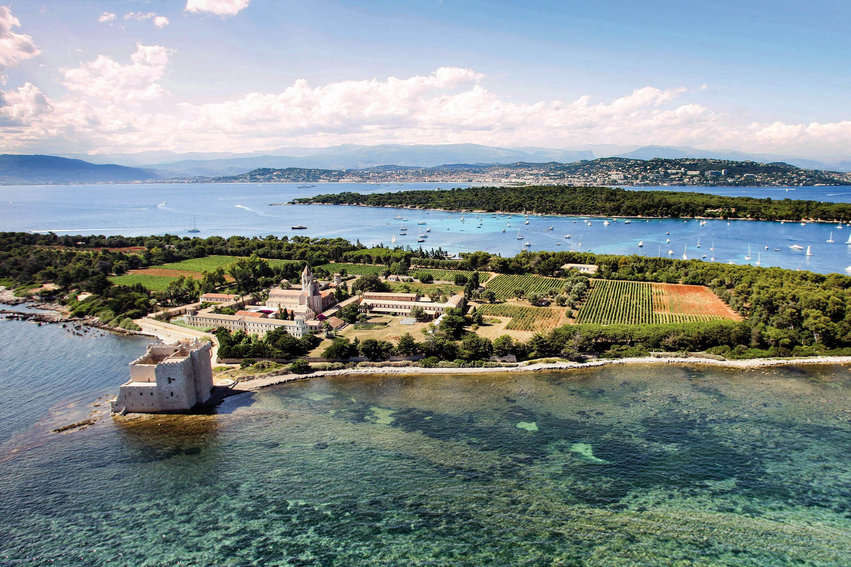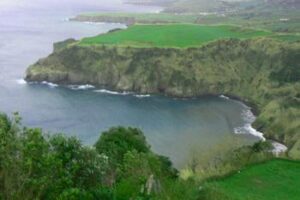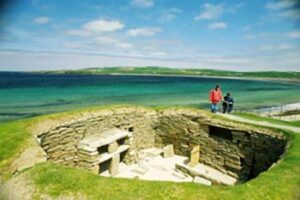
Discover the Lérins Islands Archipelago in Cote d’Azur
By Sharon Kurtz
GoNOMAD Senior Writer
While rolling through Provence on a slow travel train from Bordeaux to Cannes, I was greeted by vistas of lavender fields and olive groves. From my window, the vibrant hues of purple and green painted a picturesque scene. 
My anticipation grew as we approached star-famous Cannes, the pearl of the French Riviera.
I was captivated by the stunning, jagged, busy coastline that stretches along the city and the azure blue waters of the Mediterranean Sea glistening over sandy beaches. In Cannes, the rest of the coast has plenty of rocks.
After dropping my bags, first on my agenda was a stroll along the Boulevard de la Croisette, Cannes’s most famous and iconic promenades. It stretches along the waterfront of the Bay of Cannes, offering stunning views of the sea lined with palm trees, luxury hotels, and high-end boutiques.

As I approached the Palais des Festivals et des Congres, where the Cannes Film Festival is held, I conjured images of celebrities and filmmakers posing on the iconic red carpet entrance stairs instead of the tourists in T-shirts and sneakers waiting their turn.
Mediterranean Islands Surprise
At breakfast the following day, my concierge gave me a tip about a group of islands nestled off the coast, the Lérins Islands. A oasis archipelago with an intriguing history, he recounted a tale of a fierce dragon, winemaking monks, and the mystery of the Man in the Iron Mask. I was intrigued—who wouldn’t be?
All I had to do was hop on the ferry at Quai Laubeuf near the Old Port area. The morning ride across the sparkling bay of Cannes was short, and the air was crisp and salty, carrying the refreshing scent of the sea. Stepping ashore, I discovered the magical allure of the Lérins Islands. It’s always exciting to disembark from a boat in the sunshine, a new place awaits.
The Lérins Islands

The archipelago comprises two main islands, Sainte-Marguerite and Saint-Honorat, small islands just off the coast of Cannes. As I approached, I loved the island’s natural beauty and tranquility, that starkly contrasted with the glamorous atmosphere of the mainland.
Not accessible to cars, bicycles, or scooters, the Lérins Islands offer peaceful getaways for rambling walks and long lazy lunches. Spreading oak trees and umbrella pines cover both islands, and a fragrant scrubland of myrtle, rockrose, honeysuckle, and wild clematis line the tranquil paths.
A Tale of Mystical Origins and Spiritual Refuge

According to the local legend, a fearsome dragon once terrorized the Lerins Islands, causing destruction and fear among the inhabitants. However, Saint Honorat, the founder of the Lerins Abbey, bravely confronted the dragon and tamed it with his divine powers.
As a tribute to this legendary event, the city of Cannes adopted the dragon as its symbol. The iconic Cannes Dragon can be seen in various forms throughout the city, including sculptures, statues, and emblems. It serves as a reminder of the courage and triumph of Saint Honorat and the significance of the Lerins Islands, unique to the history and culture of Cannes.

The Chronicle from the Beginning
The Lérins Islands were initially inhabited by the Ligurians, an ancient Mediterranean people. Later, the Romans recognized the islands’ strategic position and established a military presence there, (of course!) using them as a base for their regional naval operations.
The Lérins Islands became a stronghold of Christianity in the Middle Ages. In the 5th century, the islands became home to a community of monks who established monasteries on both Sainte-Marguerite and Saint-Honorat.

Monastic communities played a crucial role in preserving knowledge, culture, and spirituality during a turbulent period in European history. In the 7th century, Saracen pirates repeatedly attacked and ravaged the islands. The monks were forced to flee, and the island’s monastic life declined for some time.
Maritime Power & Political Intrigue
Maritime Power defined the islands’ 14th and 15th centuries. The islands served as a strategic outpost for the powerful House of Grasse, influential maritime merchants, and naval commanders. They used the islands as a base for their naval activities and to protect their trade routes in the Mediterranean.
Over the centuries, the islands witnessed numerous conflicts and changes in ownership. They were ruled by various powers, including the Kingdom of Arles, the Republic of Genoa, and the Kingdom of France.

Biodiversity and Nature on the Islands
The islands are now a protected natural area, preserving diverse ecosystems.
The Étang du Batéguier is a unique spot where seawater mixes with fresh water, attracting various bird species as a migratory bird reserve. Along the coastline, posidonia seagrass meadows provide refuge for aquatic wildlife, making it a popular destination for snorkeling and diving.
Off the coast of Saint-Marguerite is one of the world’s only underwater art installations. The underwater “Eco Museum” is a permanent installation of environmentally-sensitive materials intended to explore the aesthetics of decay, rebirth and metamorphosis.

Sainte-Marguerite Island
Île Sainte-Marguerite boasts almost 14 miles of hiking trails covered in towering oak and fragrant pine forests, making the island a paradise for wildlife enthusiasts. The island is home to the Musee de la Mer within the Fort Royal. It showcases archaeological artifacts and exhibits related to the region’s marine life and maritime history. It also houses the famous Iron Mask Cell, where the “Man in the Iron Mask was allegedly imprisoned.
The legend is shrouded in mystery and speculation. During the late 17th century, a masked prisoner resided on the island, his true identity concealed. Numerous theories have emerged, suggesting he was a disgraced nobleman, a royal figure, or even a twin brother of King Louis XIV.
However, concrete evidence supporting any specific theory remains scarce. Historical records often refer to him as “the man in the mask” or “the unknown prisoner,” failing to provide definitive clues. A fictional book by Alexandre Dumas, part of Dumas’ “D’Artagnan Romances” series, has popularized the legend, blurring the lines between fact and fiction.

Saint-Honorat—Isle of Sacred Vines
Saint-Honorat, the smaller and more spiritual island, has been included on France’s national tentative list as a UNESCO World Heritage Site.
As you step off the ferry onto Saint Hororat Island, you are greeted by the tranquil atmosphere of the island’s Cistercian monastery. The monks who reside here have been producing wine for centuries.
The island boasts stunning coastal landscapes and lush greenery, creating a picturesque setting for ambling walks. As I explored the island further, I discovered secluded coves and pristine beaches, which led me to a narrow spit of land with a captivating view of the Saint Honorat Tower.

This historic structure, built in the 16th century, defended against pirate attacks when the Mediterranean was plagued by maritime threats. The tower stood solid and proud, a testament to the island’s rich history and the resilience of its inhabitants throughout the centuries. The tower is currently undergoing restoration.
The Island’s restaurant, La Tonnelle, provides spectacular sea views for a leisurely lunch. The seafood is as fresh as can be, and the ambience of watching the passing boats is priceless. The gift shop offers souvenirs and products made by the monks, including wines, honey, olive oil, and handmade soaps. You can probably get a taste of some of their wines along the way.

Lerins Abbey Cistercian Monastery
Visitors can enjoy a peaceful moment in the majestic Abbaye de Lérins, the monastery founded by the monks, with a rich history dating back to the 5th century. The abbey is still active and inhabited by a community of monks who have resided on the island for centuries, including a church, cloister, and various buildings.
Twenty-one monks currently make up the community. A center of spirituality and learning, the monastery focuses on prayer, manual labor, and self-sufficiency. Despite challenges, the monastery thrived and continues to preserve its spiritual heritage today, welcoming visitors seeking a peaceful retreat or a glimpse into their way of life. The abbey offers guided tours, allowing visitors to learn about the island’s spiritual and historical significance.
Vineyards and Wine Cellars

The picturesque vineyards, set against the backdrop of the azure sea, produce unique “Lérins wines.” With a vibrant winemaking tradition, the monks of the Lérins Abbey have been cultivating their vines with skill and passion since the 5th century. Every stage is carried out by hand. They produce various wines, including red, white, and rosé. The high-quality wines have won numerous awards and accolades for their quality and craftsmanship.
The monks also produce a variety of liqueurs. The liqueurs are made using traditional recipes, and methods passed down through generations of monks. Some popular liqueurs the monks have include the Lérina, a herbal liqueur made with 50 different plants and herbs, and the Lérincello, a lemon liqueur made from organic lemons grown on the island, showcasing the monastery’s craftsmanship and dedication to its traditions. Visitors to the island can purchase these liqueurs as souvenirs or enjoy them at the island’s restaurants and cafes.

The Charming Harbor
The ferry dock in the harbor on Saint Honorat is a charming and functional area serving visitors’ main point of arrival and departure. Despite its small size, it offers a warm and welcoming atmosphere, allowing you to easily transition from the ferry to the island and back to the mainland.

The harbor presents lovely views of the island’s natural beauty. The cerulean waters of the Mediterranean Sea stretch out before you, punctuated by small boats bobbing gently in the waves. The gentle lapping of the waves against the dock and the distant sounds of seagulls creates a soothing soundtrack.
Despite their proximity to the bustling French Riviera, the Lérins Islands today still offer a peaceful and idyllic escape. Away from the crowds of Cannes, the islands provide a tranquil environment perfect for relaxation and rejuvenation. The combination of natural beauty, historical significance, cultural heritage, biodiversity, and tranquility makes the Lérins Islands unique and a destination worth exploring.
Getting to Lérins Islands
The ferry to the Lérins Islands leaves from the Port of Cannes. Specifically, you will find the ferry departure point at Quai Laubeuf, near the Old Port area of Cannes. The website is www.trans-cote-azur.co.uk. Ferries to each island depart every 4 hours and leave 7 days a week to each island. The round-trip ticket is less than 20 euros.
Sharon’s visit to Cannes was hosted by http://www.cotedazurfrance.fr. All opinions are her own. For more information about Cannes and the Lérins Islands.
- Jasper, Alberta: Winter Perfection - April 3, 2024
- Whooping it Up in Port Aransas, Texas Gulf Coast - March 21, 2024
- South Dakota Surprises - January 19, 2024






The underwater museum intrigues me!
Great article! A mine if fascinating information:)